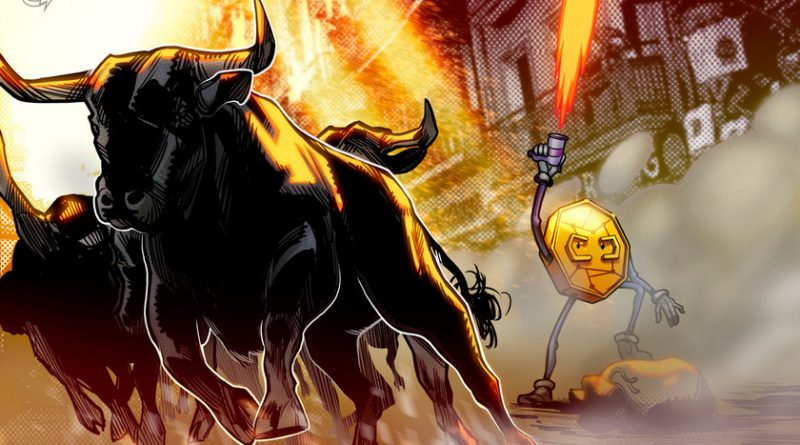Bitcoin options open interest sets new high sparked by rising liquidity
Bitcoin options open interest hits an all-time high as increased liquidity points to investors still being bullish on BTC.
Open interest for Bitcoin options hit their all-time high of $2.14 billion on Sept. 24, a day before a huge quarterly expiry of 89,100 contracts — i.e., 47% of existing options contracts at the time. Options are derivative contracts that give the holder the right (though not an obligation) to purchase or sell an underlying asset at a predetermined price, also known as the “strike price.”
Observing the OI trends before every monthly and quarterly expiry, there are spikes just before the date of expiry, and they have been incremental after each expiry, pointing toward the increased liquidity in the Bitcoin (BTC) options market and an increasing number of investors participating.

Since this past expiry was a quarterly expiry for Q3, it was expected that the open interest would surge past the OI seen in the prior monthly expiries of the same quarter. Cointelegraph discussed this further with Shaun Fernando, the head of risk and product strategy at Deribit — a crypto derivatives exchange — who agreed by saying that “the trend of open interest increasing every quarterly expiry signifies a trend of an increase in liquidity in options,” further adding:
“The longer an expiry exists for, the more the open interest can increase as traders take positions in that expiry. So, the March 2021 expiry was introduced at the end of June, which gives it more time for positions to be created on than a daily expiry, which would generally have two days of existence. Hence quarterlies are correlated in open interest.”
Besides high OI being related to the liquidity of options and the increased number of market participants, they could also be driven by larger macroeconomic events within the crypto markets such as the decentralized finance hype and long term effects of the Bitcoin halving on the markets. Lennix Lai, the director of financial markets of OKEx crypto exchange, echoes this evaluation while addressing the reason why there is an immediate drop in OI immediately after expiration:
“Open interest is normally correlated with expected uncertainty and events that are expected to have a fundamental impact on the price of the underlying. So, the OI on September’s expiry is reasonably larger because of the major industry-impacting event of the third Bitcoin halving in May and overall DeFi hype — and so, the larger OI reflects investors’ needs to hedge with options over the past few months. The drop in OI afterward indicates that such a need for that type of event-based risk management is comparably smaller now.”
The increasing trend in open interest in BTC options seems to be a positive sign for better things to come for the crypto derivatives market, according to Lai: “Indeed! The sign of the increasing open interest potentially reflects that more participants are entering the market. Furthermore, any additional stimulus to the market can set up an aggressive stage for BTC options.”
Minimal price movements
Despite the price volatility expected prior to this expiry where nearly half of all Bitcoin options contracts in circulation were due for expiration, there was no significant price impact. One main reason for this could be the size of the options/derivatives market when compared to the spot BTC market. Although, investors hope that the options and futures market would grow to be a larger fraction of the spot BTC market, which has a market cap of $194.11 billion. Lai further opined that “the price influence is not as strong to create large variance,” adding: “While there is no direct correlation between OI and post/pre-expiry price in traditional markets, crypto markets do not stand aside.”
Apart from this main underlying reason for why there isn’t a significant price movement is that the put-call ratios haven’t been heavily skewed toward one side. A put contract is an options contract that allows the holder the right to sell a specified amount of an underlying asset at a fixed time within a specific duration, whereas a call contract gives the holder the right to sell the underlying asset under similar prerequisites. Dan Koehler, liquidity manager at OKCoin — a San Francisco-based crypto exchange — elaborated:
“The growing open interest in BTC options can have a foundational impact on the spot market if there comes a time where there is a large position imbalance where the put-call ratio is heavily skewed toward one side. During such occasions, when expiry occurs, if the large portion of in-the-money options are exercised, the contract being assigned will cause price action on BTC at the predetermined strike, this would pressure the spot market prices in response.”
“In the money” options refer to options that hold intrinsic value to the investors. An ITM call option means that option buyers would have the opportunity to buy the asset below its current market price, while an ITM put option gives the buyers an opportunity to sell the asset above its current market price. These are looked at as an “out of the money” options contract.

The put-call ratio has been relatively stable, averaging around 0.7 over the past month, which indicates that there is still a bullish sentiment among investors despite the BTC spot price contracting $900 earlier in the expiry week.
Although these are the major points, there are many factors within options expiration that play a role in whether the price of the underlying asset will see a larger price movement. Koehler points to “strike concentration of the 89K in OI” as being another significant aspect: “If the strike open interest doesn’t coincide with the current price of BTC, then the market makers will need to do less last-minute hedging that could result in pinned or slippery strikes.”
Options impact spot markets
Apart from options playing a role in indicating market sentiment near options expiration days, they are often an indicator of this sentiment as well. Fernando stated that “options can already have had an effect on the underlying before settlement,” further adding:
“We have in the past seen whales trade options which could be used as a leading indicator for the underlying — this effect can be twofold, as counterparts hedge out the delta in the underlying but also since those whales might be looking to extract as much value from any large directional future trades they might be looking to execute.”
Options serve various purposes for different kinds of investors. Risk-averse investors use options as a hedging tool that serve to reduce risk in their portfolios. For speculators, options offer a chance to have low-cost ways to go long or short on the market with limited, calculated downside risk. Options also give opportunities to potentially profit under any market scenario using flexible and often complex strategies like spreads and combinations.

BTC options traded on the Chicago Mercantile Exchange are referred to as “CME options on Bitcoin Futures.” They are often a sign of institutional interest in Bitcoin, which also seems to have increased leading up to the Sept. 25 quarterly expiry. Cointelegraph discussed the role of these options with Tim McCourt, the global head of equity index and alternative investment products of the CME Group, who stated:
“Our CME Bitcoin options are off a strong start this year. Since their January 13 launch, more than 27,000 contacts, equivalent to 135,000 Bitcoin, have traded. Our options are designed to help both institutions and professional traders manage spot market Bitcoin exposure, as well as hedge their Bitcoin futures positions.”
The opportunities that options and the derivatives market, in general, given to investors have contributed to increased price stability that is currently being witnessed for Bitcoin. The ability to take a plethora of opposing positions, through instruments like longs/shorts and puts/calls, has helped lessen the large and frequent price swings seen with Bitcoin in the past. Koehler added:
“The growing development of crypto infrastructure, such as trading, risk and portfolio management, and liquidity aggregation systems are also helping to mature traders’ price discovery process. These improving developments are creating a case where, although we may be reaching ATHs in OI, BTC prices may move in steady gradual increments than with very large instant price impacts due to increasing open interest.”




